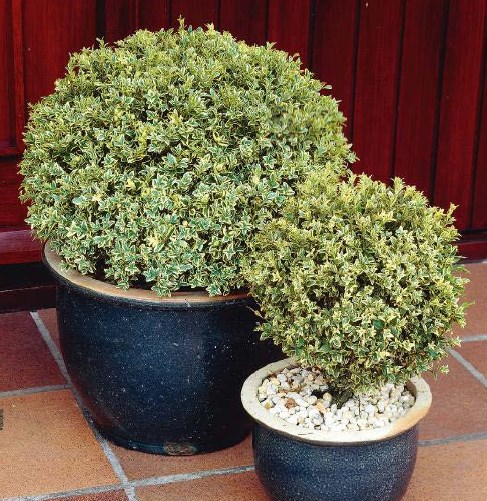 |
| Pieris japonica ‘Katsura’ Stunning mahogany-red new leaves. Sprays of crimson stained flowers in early spring. Plant in lime-free compost. 3ft x 2ft (90cm x 60cm) |
Many shrubs make wonderful long-term subjects for pots and, unlike seasonal bedding plants they can provide color and interest throughout the year. Although the initial outlay may be more than your usual seasonal selection, in the long term they are better value and far more rewarding. I grow a wide variety of shrubs in pots and use them to bring the garden onto the terrace, driveway and any other paved areas where planting in the ground is not feasible.
They make great focal points, and the wonderful thing about growing in pots is that you can change the planting picture so easily by moving them around, or by grouping them with a pot of bulbs, violas or perhaps a geranium or verbena for summer color.
 |
| Pittosporum tenuifolium ‘Variegatum’ Dense and bushy with waved, blue-green leaves edged with cream. Good in sun or shade. 4ft x 2ft (1.2m x 60cm) |
Colorful foliage
However they are perhaps at their best with the warm tones of red leaves and stems. I often use Cornus sanguinea ‘Midwinter fire’ or Acer palmatum ‘Sango-kaku’ in a terracotta pot on the terrace in winter. The latter, known as the coral-bark maple is stunning when the sun catches its red twigs with the warm tones of the clay.
 |
| Prunus incisa ‘Kojo-no-mai’ Pink buds open to delicate white flowers in early spring. Leaves turn scarlet in autumn. Gives the effect of a bonsai grown in a pot. Deciduous. 3ft x 2ft (90cm x 60cm) |
Long-term success
When it comes to planting up your container, I recommend that you choose a pot that the shrub is going to be happy in for a few years. If you use the right compost and feed and water regularly, a shrub can be happy in the same pot for five to ten years, or even longer.
The secret of success is to choose nice, big, good quality pots at the outset. I promise you, they always look a lot bigger at the garden center than they will when you get them home.
 |
| Euonymus japonicas ‘Green Rocket’ Upright stems packed with rounded dark green shining leaves. Striking and architectural. Ideal for small, modern shady gardens. 3ft x 1ft (90cm x 30cm) |
 |
| Buxus sempervirens ‘Elegantissima’ Variegated box with creamedged small, deep green leaves. Excellent in shade. 2ft x 2ft (60cm x 60cm) |
 |
| Leucothoe Scarletta ‘Zeblid’ Emerging leaves are dark purple, turning green as they mature, then finally turn bronze and wine-red in winter. Plant in lime-free compost. 18ins x 18ins (45cm x 45cm) |
 |
| Skimmia x confuse ‘Kew Green’ Green flower buds in winter open to large clusters of lily-of-thevalley scented flowers in spring. 2ft 6ins x 2ft 6ins (75cm x 75cm) |






